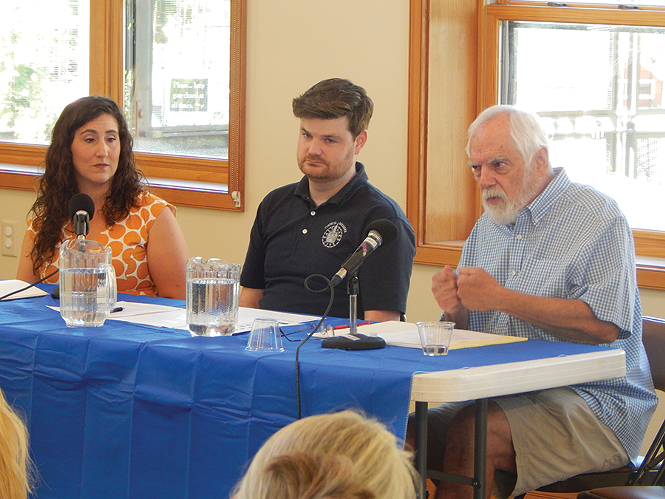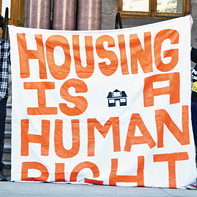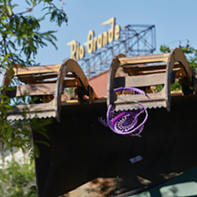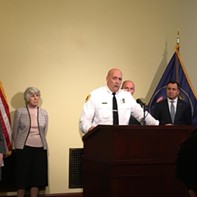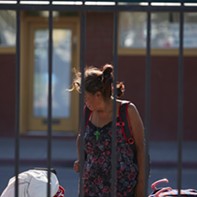The Road Out
How religious organizations, nonprofits and people on the streets are adapting to historic change in Salt Lake's homeless services.
By Peter Holslin @PeterHolslinFor 32 years, the Good Samaritan Program has operated out of a three-story house with an expanse of green lawn on South Temple, offering bagged lunches to hundreds of hungry people every day.
The program, run by the Cathedral of the Madeleine, has become such a reliable resource for the homeless and working poor over the years, that volunteer coordinators developed a DIY mass-production process to keep everything running smoothly. Every morning, a team of volunteers lay out slices of bread on a giant table, adding cold cuts and cheese, slathering on a mix of mayo and mustard, slapping together sandwiches 250 at a time. Then they pass them off to another crew in an adjoining room, who drop chips, granola bars, fruit or cookies into the bulging plastic sacks.
"It's like a holiday rush in a movie. It's just crazy," Scott Helferty, a 72-year-old retiree, said as he described his experience as a volunteer over the past three years.
The program is meant to be a source of stability for those who have otherwise been left behind. The house runs from morning till night, 365 days a year, with no interruptions on weekends or holidays.
But those days are over.
Last month, Helferty said he and other staff and volunteers panicked over rumors that the Good Samaritan Program was shutting down. Days later, signs appeared on the front windows announcing that, beginning in October, the program will cease operations at the house and move to the St. Vincent de Paul soup kitchen, run by Catholic Community Services in the Rio Grande neighborhood.
After all these years, the Rev. Martin Diaz of the Cathedral of the Madeleine tells City Weekly, the program suddenly started facing problems it could no longer handle in its current space. Amid rising rents, an opioid epidemic and the fallout from Operation Rio Grande, Diaz and others have seen a change in the kinds of individuals coming to the house. Some have been camping outside overnight, relieving themselves in public because they have no access to bathrooms. People have used drugs, leaving behind hypodermic needles and other paraphernalia.
"There's an opioid crisis, and the result of that is just more and more illegal drug use. We're seeing kind of a different clientele," Diaz says, delicately summing up some recent issues. "Each year, there's just more and more need."
'A COMPLETELY HISTORIC RESET'
The Good Samaritan program is just one of many resources forced to adapt as the city and county implement major changes in dealing with the homeless population.
Over the past few years, officials have been gradually pushing the homeless out of the downtown area, where services and support networks have been based for decades. The process began with Operation Rio Grande, the crackdown launched in August 2017 against drug dealing and violence in the neighborhood surrounding downtown's The Road Home shelter. Now, these efforts continue with the opening of three new homeless service centers, dispersed across Salt Lake City and South Salt Lake. As soon as clients settle into the new centers, The Road Home—Utah's largest shelter, outfitted with 1,100 beds—is expected to permanently close. And while many welcome this new change, there are also concerns about its effect on the long-running systems of support for some of the city's most vulnerable people.
"This is a completely historic reset on how we're providing homeless resources in our community," Preston Cochrane, executive director of SLC-based nonprofit Shelter the Homeless—which owns the three new resource centers as well as The Road Home—says in an interview. "For folks that have been chronically homeless and in and out of the shelter system, this is a complete change from what they're used to."
The Road Home has been the main destination for homeless people in Utah since it opened in 1988. The space was originally run by a group called the Travelers Aid Society, part of an international movement dedicated to providing support for itinerant families and migrants with no other place to lay their heads for the night. In 2001, the group changed its name to The Road Home, reflecting an updated mission to help people move out of shelters and into permanent housing.
In recent years, real estate and business owners around The Road Home and Pioneer Park have pushed to close the downtown shelter—an effort that some advocates suspect has to do more with development opportunities than with actually solving homelessness.
"Our position is that primarily it's been about the retail value of downtown. The city is being gentrified, and so our homeless folks put a damper on selling land," says Jessica Roadman, community outreach coordinator at Crossroads Urban Center, a Salt Lake-based food pantry and advocacy group. Naturally, this leaves lingering questions about how to address more deep-rooted causes of homelessness, like drug addiction, mental health and fast-rising rents.
"What happens with transportation? What happens when people come into the shelter and they're maxed out, because the housing market isn't changing and we're not putting any money into affordable housing?" Roadman says. "The city has been doing some good work—forward-moving work—in terms of affordable housing. But we need a lot, and we need a lot fast."
NO TIME FOR ANYTHING
Some people who've stayed at The Road Home and hung out in the Rio Grande neighborhood say they welcome change. They say police often hassle people for loitering and other minor infractions, while inside, the infrastructure is old and drug use is still common.
"When you walk in there, man, it's a mess," Brian Cruz said. He recently arrived in Salt Lake City from San Diego—he said he ended up here by mistake after drinking too much, passing out in the back seat of his Utah friends' car and waking up in Las Vegas. He's been homeless before, and since arriving in Utah he's been trying to pick himself back up again, making friends with others on the streets and visiting the Social Security office to get his paperwork together. But he hasn't slept at The Road Home because the conditions were intolerable. "As soon as I walked in there, dude, I walked out with a bunch of bedbugs."
Leo, an artist who has lived on the streets and in shelters across the United States and is now in Salt Lake, said he likes the idea behind the new service centers. Although they're spread out, each facility is built to serve as a one-stop shop where people can access food, health care, case management and other resources, cutting down on the need to schlep around all day on the bus.
"It was a pain in the ass before—go all over town to get all your different things that you need. Then you miss out on the meals, you know?" he said, sitting on a patch of pavement outside a café on 100 South with a pack of pens and drawing paper by his side. "It's hard to leave and try to do anything to better your life outside of the shelter. You're standing there all day long just to get breakfast, a shower and lunch, and by that time it's 3 in the afternoon and you have no time to go look for a job or anything."
Still, some advocates wonder if the new service centers are enough.
GETTING ON TOP
On a recent weekday morning outside the Good Samaritan house, Michael Duran was dressed for work in a blue polo shirt and khaki pants. Erica, his wife, also looked crisp in her button-up shirt and earrings.
They've chosen to hunker down in the shelters and service centers lately as they build up enough money to become financially stable. Married for seven years, they used to be fully employed, Michael supervising workers on a production line at a meat-packing plant. He quit to look for a better-paying job, but ended up stuck doing low-wage gigs, struggling to find a position because he had a criminal record and most employers only wanted him for entry-level work.
The couple say they're now in an odd position: They're not solvent enough to afford all the basics like a car, apartment and groceries, but they're also not poor enough to where they're confident they'll qualify for public assistance.
"If we ever make any more money, then we're kicked off," Erica said of programs like SNAP (the Supplemental Nutrition Assistance Program, formerly known as food stamps) and subsidized housing. "We'd rather just kind of struggle for a while until we get up there where we don't need that."
Erica had been trying to get a spot in the Geraldine E. King Women's Resource Center at 131 E. 700 South just off State Street. But she kept missing her chance because she was away from The Road Home during the day—the same time when service providers were stopping by the downtown shelter to relocate women to the new facility.
"We go out and we do things. We don't want to sit there all day," she said.
"All these struggles on top of each other, just everything adds up and builds up. It's hard doing all of this," Michael added. "But we're pushing through. We'll get on top."
'FIGHTING TOOTH AND NAIL'
According to Utah's 2019 report on homelessness, a comprehensive statewide head-count one evening in January found 2,798 individuals spending the night without a proper home across the state. Eighteen percent of them were considered "chronically homeless"—a category that describes someone who's living in shelters or on the streets long-term, usually because of severe disabilities or drug problems. However, many more of the people in the count were in situations like the Durans, cycling in and out of homelessness or experiencing it only transitionally as they struggle to get back on their feet.
Homeless advocates seemed to have people like the Durans in mind at the 16th annual Poverty Summit, a symposium organized by the Crossroads Urban Center held on a Saturday morning late last month. Homeless advocates, service providers and elected officials spent the morning discussing gaps between housing and homelessness at the Cathedral Church of St. Mark.
"What I see in our community are red flags everywhere," Sen. Derek Kitchen, D-Salt Lake City, told the audience. "In many ways, we are a victim of our own success—this longstanding effort that the state of Utah has put on economic development is generally a good thing. But look at what it's doing. We have rising rents. Residents are being priced out of their neighborhoods, where they've lived for their whole lives ... We are seeing the cost of living skyrocket in our community, and that itself makes escaping poverty that much more difficult, especially for people who are living on the edge day to day."
State lawmakers once promoted a "Housing First" policy to prioritize getting homeless people into affordable living arrangements. In a much-publicized story, Reuters reported in January these efforts led to a much-touted 91-percent drop in chronic homelessness in Utah by 2015, yet the funding has dried up in recent years and the number of people camping on the streets has nearly doubled since 2016. During the past legislative session, lawmakers pledged to set aside $24 million to support affordable housing, only to axe the funding at the last minute.
As TV cameras rolled for a debate at the poverty summit, Salt Lake City mayoral candidates Sen. Luz Escamilla and City Councilwoman Erin Mendenhall stressed the need for more affordable housing, talking specifics about redevelopment plans and single-room occupancy hotels.
But not all the discussions were so cordial. On a panel with City Councilman Chris Wharton and Salt Lake County Councilwoman Shireen Ghorbani, veteran Crossroads advocate Tim Funk vented about the Legislature's sudden turnaround on affordable housing. At one point, he suggested that lawmakers dedicated to the issue blew it at a key moment. "The opportunity has been lost," he sighed.
Sitting in the audience, Rep. Angela Romero, D-Salt Lake City, an outspoken advocate of affordable housing, suddenly got up and walked out in frustration. Ghorbani got on the mic to defend her.
"We have representatives who are fighting tooth and nail for these dollars—one of them being Angela Romero," Ghorbani said. "And we need to support those candidates. If you have seen somebody here today, that means that they care about this issue and we need to be out there working for them and supporting them."
THE FUTURE IS MOBILE
The Road Home was supposed to close on June 30, but the deadline has been extended multiple times. According to Cochrane of Shelter the Homeless, the plan now is to shutter the shelter once everyone staying there has been relocated to a new service center. The Gail Miller Resource Center at 242 W. Paramount Ave., built for men and women, opens this month. The 300-bed men's facility at 3380 S. 1000 West in South Salt Lake is expected to open some time in October.
To change with the times, some providers have been branching out. Fourth Street Clinic, a community health center located across from Pioneer Park, recently invested in a custom-built mobile clinic that can provide checkups, hepatitis C treatments and other health care services for the clinic's homeless client base. The mobile unit is 45 feet long, with five-inch-thick walls, a checkup room and a colorful exterior paint job of the Salt Lake skyline. It's basically the rock 'n' roll tour bus of mobile clinics.
According to Laura Michalski, Fourth Street Clinic CEO, the mobile unit will cost half a million dollars per year to operate, with the first year covered by the state. But this doesn't mean the facility is moving out of downtown for good. The clinic has invested heavily in its downtown property, including building a four-chair dental clinic on site that opened in 2014. The clinic owns the property and about 50% of its budget comes from a branch of the U.S. Deptartment of Health and Human Services—federal backing that Michalski says will give the clinic leverage to resist any potential efforts to push it out of downtown, like what happened with The Road Home.
Still, as a community health center specifically designed to serve the homeless, Michalski says they'll be watching closely to see how they can best serve clients. "We do an annual needs assessment to look at, 'Do we have the patient numbers that would warrant us staying here?' We're required by the federal government to do this," she says. "If we see a drop in numbers, we need to be able to discuss that and explain why. What are we doing to do outreach? Is this the best location? ... The reality is, we really need to look at the community that we're serving."
FULFILLING A NEED
Down the street from Fourth Street Clinic, at the St. Vincent de Paul soup kitchen, power drills wheeze and the smell of fresh paint hangs in the air as contractors hustle to finish a remodel. CCS, sponsored by the Catholic Diocese of Salt Lake City, has a big presence among vulnerable communities in Utah: It's one of two organizations responsible for resettling refugees into new homes around the state, and it also provides homeless services in the Rio Grande neighborhood.
According to Randy Chappell, the organization's associate director of homeless services, CCS currently serves more than 700 hot meals a day to people who stop by the dining hall for lunch and dinner. That number is about to double, with CCS now operating the Gail Miller Resource Center and gearing up to make daily deliveries of spaghetti and meatballs, cheeseburgers and other dishes to all three new service centers. Staff has spent the past four months overseeing construction to expand its kitchen, allowing them to cook the meals they'll deliver, and also making room for the Good Samaritan program to operate out of the space.
But that's not all. CCS is also making plans to launch the St. Vincent's Kitchen Academy, a 12-week culinary arts training program for homeless individuals to help them develop useful skills and find employment. Developed in partnership with the Catalyst Kitchen, a national program based in Seattle, CCS' cooking school will include 10 weeks studying in the kitchen and two more weeks doing a residency at local restaurants, with a case manager following up with each student for a year.
"They'll have chef outfits," Chappell boasts.
Chappell expects to see fewer homeless folks around Rio Grande with the new service centers, but he and CCS spokesperson Danielle Stamos still see a need for a dining hall where anyone—from a man camping out on the street to a low-income family hoping to save some cash—can get a free meal, no questions asked.
"I think we know our numbers will drop, but I think there will still be enough around that it'll make it worth it," Chappell says.
HELP YOURSELF
The American Dream is a story of hard work and winning; but what about the ones who end up at the bottom? Jia Tolentino, a staff writer at The New Yorker, argues in her new book, Trick Mirror, that the parameters for economic survival in America are getting more and more extreme in this age of rapid expansion, rising prices and relentless tech reinvention. She's just one of many critics of a system that to many seems less dreamy by the day. At the Crossroads Urban Center, Jessica Roadman sees economic instability as a slippery slope, with the rock-bottom struggles of homelessness just one symptom of a systemic problem.
"We have this narrative that's like, 'Pull yourself up by your bootstraps!' We're such an individualistic culture that we forget that there's so much else at play," Roadman says. "One thing that I think is hopeful—it's sort of a dark hope—but as more and more people feel that that narrative doesn't make sense anymore, change is going to be forced. We're losing the middle class. There are fewer and fewer people who are in their life experiencing home ownership ... There's a point where people are getting fed up with having to work four or five jobs and barely get by."
Brian Jones, a Road Home resident who grew up in Utah, says it's a bit nerve-wracking to think about how the system will change as he gets ready to leave the downtown shelter and move to one of the new service centers. If he can't get in a steady-enough financial position in time to move into affordable housing, he's expecting to relocate to the as-yet-unopened new facility in South Salt Lake.
He wonders what kind of impact this will have on his day-to-day schedule: He currently works concessions part-time at the Vivint Smart Home Arena, just up the street from The Road Home. The South Salt Lake center, on the other hand, is 45 minutes away on public transportation. The closest "amenity" down there is the Salt Lake County Metro Jail, a half-mile walk from the new service center.
"That'll make it easier on the police, I guess," Jones jokes, as he rests up on a recent afternoon at the Weigand Homeless Resource Center—a gated community space run by Catholic Community Services near The Road Home.
Despite those concerns, Jones was feeling good about the services he's been able to access locally. He looks forward to seeing some of the same staff at The Road Home working at the new centers, and he has a positive outlook, even in his tenuous position. If he were living back on the streets, everything could fall apart. But he knows that help is out there if he needs it.
"It's all about helping yourself, too. You gotta understand that they can only offer you stuff—you have to actually ask for it," he says. "There's people here who are willing to help you. You just need to be willing to be helped."
More by Peter Holslin
-
Rebel Spirits
A Facebook group draws a bullseye on the DABC while calling for alcohol reforms.
- Dec 11, 2019
-
The Journey of Becoming You
How 'gender-affirming' philosophy and multidisciplinary care at the University of Utah's Transgender Health Program helps patients feel whole.
- Dec 4, 2019
-
Say Their Names
Transgender Day of Remembrance ceremony in the Capitol honors victims of transphobic violence.
- Nov 21, 2019
- More »
Latest in Cover Story
Readers also liked…
-
Forget the family pedigree—Robert F. Kennedy Jr should not be the next president of the United States
Trojan Horse
- Jun 21, 2023
-
Women decry harassment and toxic culture at St. George auto dealership
Men at Work
- Oct 11, 2023




